Author: Crypto Dog
This article explains what market makers are, why the market needs market makers, the DWF incident and its impact on the industry from the perspective of a "senior leek" (God's vision) who can already make "rational" analyses.
Whether it is the primary market or the secondary market, every day is filled with myths of getting rich quickly, but it seems that you will never become the protagonist in the "myth", and sometimes you may not only not become the protagonist, but even the supporting role, and can only become cannon fodder.
Most people come here not to find value investment, but to turn over. Suddenly one day we see the gods fighting, the market is surrounded by conspiracy theories, and you begin to doubt whether you have not turned over. Is it because they have taken your money? The top predators in the crypto market, market makers, who are closest to money and directly involved in transactions, have inevitably become the target of market hatred.
This sentiment has never been cut off regardless of whether it is a bear market or a bull market. For example, DWF Labs, which has invested in 470 projects in 16 months since its debut, had nothing to do with investing in so many projects, but he said that he had no shortage of money, did not raise funds, and that all the money he invested was earned by himself. Well, this offended a lot of people, such as market makers who absorbed financing. Just like Captain Jack in "Pirates of the Caribbean", he offended everyone in the sea and on the shore, and everyone who saw him wanted to hit him twice.

Cunning, scheming, market manipulation, pumping and selling, and cutting leeks are synonymous with crypto market makers. But before putting all kinds of hats on crypto market makers, as an industry "senior leek", as a "senior leek" who can "rationally" analyze, we still have to face up to the important role of market makers in the crypto market, especially in early coin listing projects.
This article explains what market makers are, why the market needs market makers, the DWF incident and its impact on the industry from the perspective of a "senior leek" (God's vision) who can already make "rational" analyses.
I hope this article can be like Captain Jack in the currency circle, and anyone who sees it will want to give me a big slap. At the same time, we also welcome the great gods who also have God's vision to come and discuss.
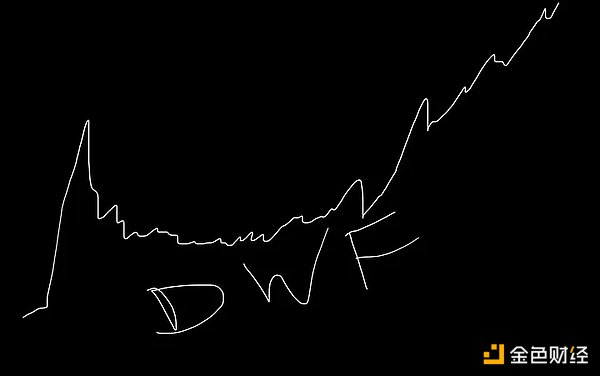
1. The market cannot do without market makers
Many people have been in the industry for a long time, but they don’t know what market makers are, why there are market makers, and even market makers are regarded as manipulators by some people because some of their actions may be considered to be trying to influence or manipulate market prices. Just like all sailors think that seeing the "Flying Dutchman" means death.
It should be noted that the "Flying Dutchman" did not create death at sea. It had a specific job, which was to transport souls at sea and allow sailors to be reborn.

Similarly, not all market makers are terrible. Meeting one means they want to cut you off. Market makers also have work content. They play a vital role in market liquidity and capital efficiency. Some tokens without capital flow can become active immediately with market makers.
Like the "Flying Dutchman", many people cannot see his face. The same is true for market makers, as if they are hidden in a corner of the crypto world, elusive, and no one will see them at the first time. They will appear where the project parties need funds, where the secondary market tokens lack liquidity, and where there is profit space.
You may be more confused when you see this. If you say market makers, you should say market makers. Why do you say Captain Jack and "Flying Dutchman" one moment? This is a metaphor, which mainly reflects the importance of market makers in the crypto world. They are hidden things in the crypto world. If it is not pointed out by the institutions, we will basically not find them intuitively.
Then let's understand what market makers are.
(I) What is a market maker?
Since the concept of finance emerged, there has been a corresponding financial "market". The most important thing about finance is liquidity. Liquidity is the force that keeps the entire financial system running smoothly; the ability to buy and sell assets quickly and efficiently is crucial to traders, investors and the entire market.
On average, there are 14 market makers per stock on the Nasdaq, and the total number of market makers is about 260. In addition, in markets with less liquidity than stocks, such as bonds, commodities and foreign exchange, most transactions are conducted through market makers.
Market makers have made great contributions to reducing volatility and transaction costs by providing a large amount of liquidity, ensuring efficient transaction execution, enhancing investor confidence, and achieving smoother market operation.
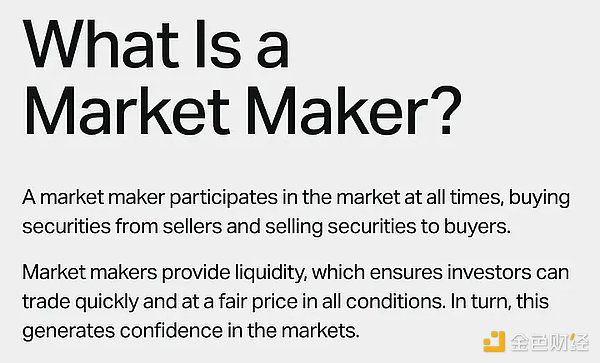
Market makers in the crypto industry refer to institutions or individuals who help projects provide liquidity and buy and sell quotes in crypto transactions. Their main responsibility is to provide liquidity and market depth for transactions in one or more crypto markets, and to make profits by taking advantage of market volatility and supply and demand differences through algorithms and strategies.
As with traditional markets, clear rules for market-making activities are essential for the smooth operation of the cryptocurrency market. Crypto market makers can not only reduce transaction costs and improve transaction efficiency, but also promote the development and promotion of new projects.
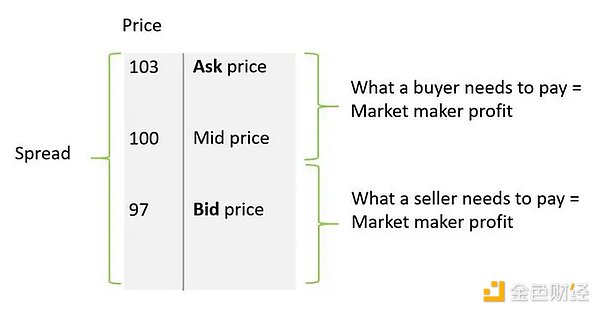
In short, market making is to provide bilateral quotes to any given market and provide the market size of both buyers and sellers; without market makers, the market will be relatively illiquid, which will hinder the convenience of trading.
(II) Crypto Market Makers and Traditional Finance
Compared with traditional finance, the crypto market market maker business is not much different in essence, but there is a world of difference in operation mode, technology, risk management and supervision:
First, the scale of crypto market makers is relatively small;
Second, the liquidity of the crypto market is relatively low and the volatility is large, so market makers need to be more cautious in risk management;
The last point is that in terms of technical architecture, the crypto industry needs to have higher technical capabilities to ensure the security of transactions. Market makers use various trading strategies to provide liquidity and make profits. Some of these strategies include statistical arbitrage, order flow trading and market neutral strategies. These strategies aim to exploit market inefficiencies and price spreads.
(III) Why do we need market makers?
(1) Provide sufficient liquidity
The main goal of market making is to ensure that the market has sufficient liquidity. Liquidity refers to the ability of an asset to be quickly and easily converted into cash without incurring financial loss. High market liquidity mitigates the impact of any trade on transaction costs, minimizes losses, and allows large orders to be executed efficiently without causing major price fluctuations.
In essence, market makers help investors buy or sell tokens faster, in larger quantities, and more easily at any given time without causing major disruptions.
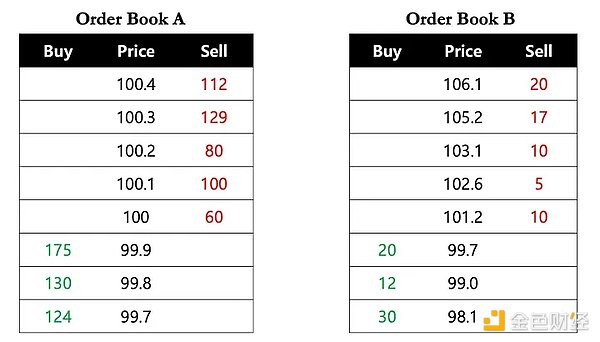
For example, an investor who needs to buy 40 tokens immediately can buy 40 tokens instantly at a unit price of $100 in a highly liquid market (order book A). However, in the low liquidity market (order book B), they have two choices: 1) buy 10 tokens at $101.2, 5 tokens at $102.6, 10 tokens at $103.1, and 15 tokens at $105.2, with an average price of $103.35; or 2) wait for a longer period of time for the token to reach the desired price.
Liquidity is crucial for early listing projects. Operations in low liquidity markets will affect investors' trading confidence and trading strategies, and may also indirectly cause the "death" of the project.
(2)Provide market depth and stabilize currency prices
In the crypto market, most assets have low liquidity and lack market depth, and even small transactions can cause significant price changes.
In the above scenario, after the investor just purchased 40 tokens, the next available price in order book B was $105.2, indicating that one transaction caused a price fluctuation of about 5%. This is especially true during market fluctuations, when fewer participants can cause significant price fluctuations.
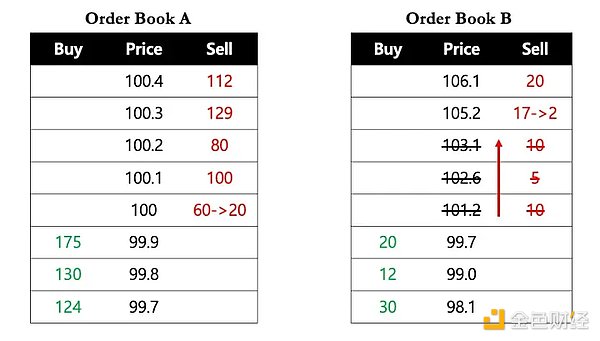
The large amount of liquidity provided by market makers forms a narrow bid-ask spread for the order book. Narrow bid-ask spreads are usually accompanied by solid market depth, which helps stabilize currency prices and alleviate price fluctuations.
Market depth refers to the available number of buy and sell orders at different price levels in the order book at a given moment. Market depth can also measure the ability of an asset to absorb large orders without major price changes.
Market makers provide liquidity to bridge the gap between supply and demand, thus playing a key role in the market.
From the market maker recruitment issued by the exchange, it is also verified that the market does not open market makers.
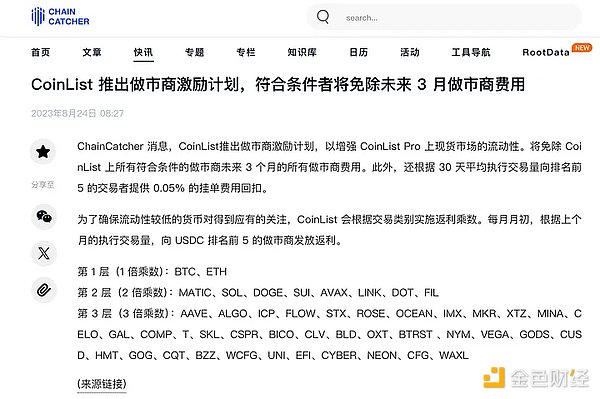
Here are some of the activities that trading platforms provide for market makers, which indirectly confirm that the industry cannot do without market makers:
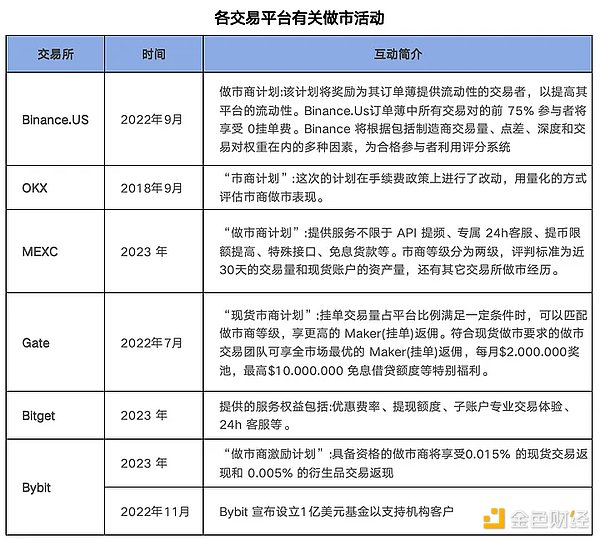
From the above, it can be seen that trading platforms also provide some services for market makers, including 0 interest loan quotas.
Market makers participate in the spot, futures and options markets, and the threshold is getting higher and higher. Correspondingly, trading platforms will also grant different privileges in different participating markets. Generally speaking, trading platforms can give market makers preferential treatment in the following items:
For market makers, handling fees are particularly critical, especially in high-frequency trading processes. Of course, in the early days of the trading platform, it is very likely that some market makers will be paid to make markets, especially for futures and options.
2. Why DWF has always been controversial
(I) The environment when DWF Labs was launched
In 2022, FTX exploded, the market collapsed, and a series of leading platforms suffered heavy losses. Market makers and lending became the hardest hit areas: Alameda, one of the largest market makers in the cryptocurrency industry, collapsed in this farce and officially ended on November 10; Genesis, a market maker and loan company under DCG, is also facing the dilemma of insufficient solvency.
The collapse of the top market makers, the destruction of a large amount of capital, and the sharp unilateral market... This caused unprecedented panic among the market makers in the industry. In the aftershocks, market makers tended to shut down, communities and projects faced huge stress tests, and the market liquidity of the crypto industry suffered a sharp decline.
DWF Labs has rapidly risen in such a market environment. The number of investment projects has increased significantly since November 2023. In just 16 months, it has invested in more than 740 projects.
DWF Labs has been controversial since its launch in September 2022. Combining some papers and interviews, we can draw the following controversial conclusions:
It has developed too fast. It has taken one or two years to complete the ten-year journey of old-fashioned market makers such as GSR and Jump, and it has not yet completed the market test period;
It is a VC and a market maker at the same time, acting as both a referee and a player, and is not recognized by its peers in the market maker industry;
Binance's doubts have once again put it on the cusp of the storm (Binance has clarified that the employees involved have been laid off)
(II) DWF Labs is not accepted in the capital market
There is also fierce competition and conflict among market makers, especially in a market environment full of changes and uncertainties. DWF Labs has been publicly excluded and attacked by its peers. The specific process is as follows:
In September 23, C² Ventures hosted the "Web3 Connect" forum during Token 2049, inviting DWF Labs and three other market makers GSR, Wintermute and OKX to participate in the discussion.
GSR is a long-established market maker founded in 2013, focusing on providing cryptocurrency derivatives and liquidity solutions to institutional clients.
Wintermute is an algorithmic market maker founded in 2017, focusing on providing liquidity for decentralized finance (DeFi) and Metaverse projects.
OKX is a leading global cryptocurrency trading platform founded in 2014, which also provides its own market making services.
GSR posted on Twitter that DWF Labs is not qualified to discuss with them on the same stage because they have no real market making capabilities and experience, nor real investment capabilities and intentions.
GSR also stated that DWF Labs is an insult to them and they will not cooperate with or recognize DWF Labs. Wintermute CEO Evgeny Gaevoy liked GSR's tweet and said they would not cooperate with DWF Labs. OKX did not make a clear statement.
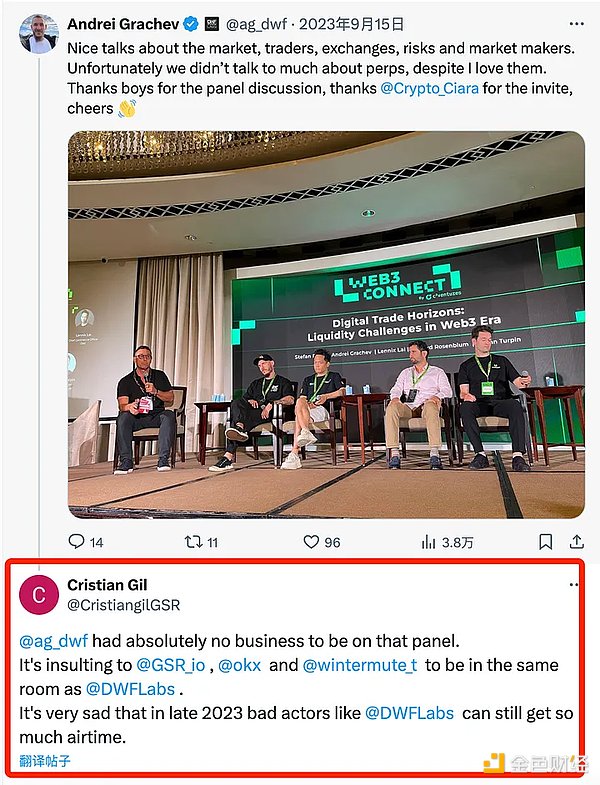
Look, the fight between gods is also magical, without martial ethics, directly hitting people in the face and exposing their shortcomings. Many people said at the time that if it weren't for DWF Labs, they wouldn't have known GSR at all. Uh... . . .
DWF Labs is not pampering its peers. Andrei Grachev, co-founder of DWF Labs, responded to GSR's accusations on Twitter, calling GSR an "old antique" that has no innovation and progress and only complains on social media. He also said that DWF Labs is better than its peers in technology, transactions, business development and other aspects. If the competition is fair, peers will definitely lose. He also mocked GSR's performance and reputation, calling them "incompetent scammers."
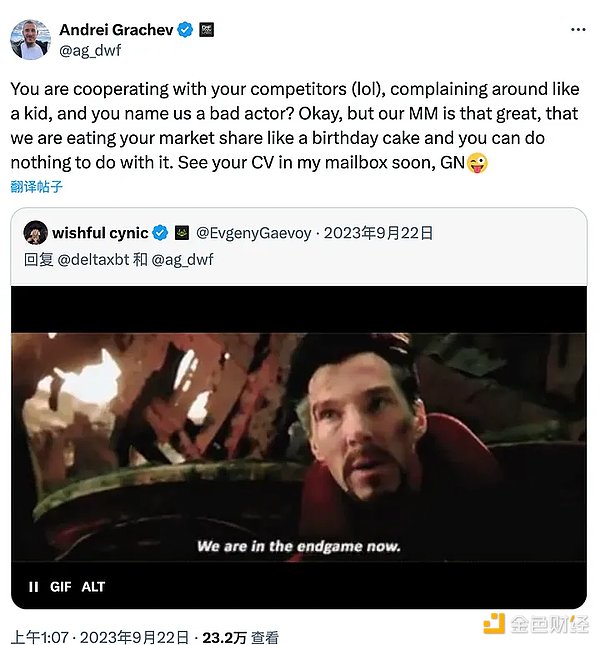
Just look at what Andrei Grachev, co-founder of DWF Labs, said: "Whether it is technology, trading, business development or other aspects, I am better than GSR." Let's disassemble DWF Labs.
III. About all aspects of DWF Labs
(I) Prequel to DWF Labs - The founder's rise to fame
The co-founder and public image agent of DWF Labs is Grachev. Although Grachev is Russian and his main business was in Europe in the early stage, he has deep roots with Huobi (now HTX) and OKX, and has a wide network of contacts in Asia. Therefore, we can see that among the hundreds of projects invested by DWF Labs, there are many Asian projects. This has a lot to do with Grachev's early work as an incubator. At the same time, it also explains why DWF Labs is both an investment institution and a market maker.
DWF was not popular 23 years ago, and its parent company Digital Wave Finance was also very low-key in Europe and the United States. It really became popular when Grachev founded DWF Labs in Singapore in September 2022. After FTX and its affiliated company Alameda closed in November, the market was in a period of confusion, and small and medium-sized WEB3 projects continued to increase liquidity with funds. DWF Labs was like a savior at that time, bringing hope to many potential projects.
The article does not end here. This article is a detailed WEB3 article, which will analyze the ins and outs of the period, so let's take a look at how Grachev, co-founder of DWF Labs, drives the prosperity of the global primary and secondary markets.
According to the timeline, Grachev's history and the opportunities of DWF Labs.
(1) Origin of DWF Labs - Operation of Huobi Russia
Grachev was born in Uzbekistan. He studied organizational management at Orenburg State University and then worked as an oil trader for two years. In 2016, he entered the cryptocurrency field by operating a small mining farm and conducting some personal transactions.
In 2018, Grachev, who was only 30 years old, became the CEO of Huobi Russia and made every effort to prepare for the launch of Huobi Russia. Huobi Russia is a local exchange officially authorized by Huobi Global (now known as HTX) through its cloud program.
The preparation of Huobi Russia is not difficult. After obtaining authorization, it is enough to recruit technical personnel to build the platform. What bothers Grachev is that if Huobi Russia goes online, what will happen if there is no liquidity? Without liquidity, there is no income.
At this time, Grachev learned that a small high-frequency trading (HFT) company in Switzerland was looking for an exchange with low interest rates. Grachev realized that this would have a significant impact on its trading profitability.
Huobi Russia only has the right to use its brand, software and trading liquidity. The listing of tokens and the adjustment of customer trading fees still require the authorization of the headquarters Huobi Global Station. Grachev spent 2 months persuading the exchange to allow him to offer preferential interest rates to the Swiss HFT company, enabling it to obtain Huobi's liquidity in a cheap way through Russian agents.
On December 8, 2018, when Huobi Russia officially launched, trading volume had reached $10 million, and the next day, the figure rose to $22 million. At this time, Grachev, the incarnation of a marketing master, began to promote Huobi Russia.
The company, called HFT, made Grachev famous and attracted the attention and scrutiny of the entire cryptocurrency community. He later became a behemoth that influenced more than 400 projects and mobilized hundreds of millions of dollars. The company would later be called DWF Labs, and this is its origin story.
(2)Digital Wave Finance was established
Three days after Huobi Russia officially launched, HFT established a company in Switzerland named Digital Wave Finance, which mainly engaged in market making and proprietary trading.
This high-frequency trading company, established on December 11, 2018, is run by brothers Marco and Remo Schweizer and Michael Rendchen. All three are traders who have worked closely with market making company IMC Trading and are proficient in automatic trading strategies. Their goal is to apply these types of strategies to cryptocurrencies.
At this time, Grachev did not join Digital Wave Finance. The three early co-founders of Digital Wave Finance seemed very low-key and rarely appeared in public, so not many people paid attention to Digital Wave Finance in the early days.
Digital Wave Finance targets spot and futures trading. By the end of 2020, Digital Wave Finance had achieved initial success and accumulated $50 million in capital in the early stages.
(3)After Grachev left Huobi
During his tenure at Huobi Russia, Grachev met Zac Zou, the regional marketing director of the cryptocurrency exchange OKEx (now known as OKX).
Before Huobi Russia was shut down, Grachev founded a Latvian entity called Vroom and launched a website called VRM Trade. One of the main strategies of the website is to incubate other trading companies and discover talents.
VRM Trade has a very big blueprint. It wants to become the most influential unicorn crypto group by investing in the next crypto unicorn company, and its core circle will form a "decentralized Wall Street". The plan is to increase its valuation to $100 million by 2021, and its core goal is to become "the most influential company that attracts all talents and "rules" the crypto world".
This may also be the reason why DWF Labs did incubation after Grachev became the co-founder of DWF Labs.
During the period from 2020 to 2012, Grachev was most closely associated with Digital Wave Finance. Due to Grachev’s connections in China, he helped Digital Wave Finance integrate with other exchanges and obtain corresponding low fees. Through the joint venture, the high-frequency trading company was responsible for token trading on major exchanges, while Grachev was responsible for interaction with the exchanges and token trading on other smaller exchanges.
By now, Digital Wave Finance has operated on more exchanges and has a high level across the board. It has a VIP 7 level on Bitfinex and OKEx, and has negative order fees on at least 7 exchanges.
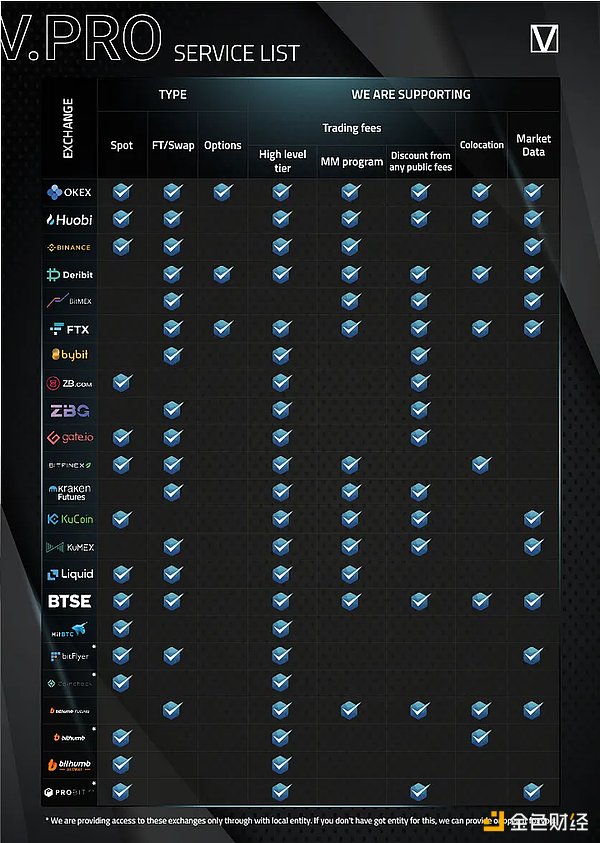
This level brings huge benefits. For example, DWF's market maker fee for placing orders on Binance is -0.002%, and the market maker fee for acquiring orders is 0.0157%. Such a low fee allows market makers to provide a steady stream of liquidity to exchanges.
(4) DWF Labs is established
In June 2022, the VRM Trade brand was abandoned, and Grachev established a Singapore entity for DWF Labs, which would assume the responsibility of being the public face of Digital Wave Finance.
Grachev, Schweizers and Rendchen were the initial shareholders.
In September, DWF Labs was officially launched, which meant the birth of a positive company. Due to the personality of the founder, DWF Labs has its own internet celebrity traffic, and it radiates brilliance wherever it goes.
(5) The growth of DWF Labs
In January 2023, Zou (formerly OKEx member), Heng Yu Lee and Ng (formerly Gemini member) also became shareholders of DWF Labs Singapore entity.
Ng is the co-founder of OpenEden, whose funds are managed by a registered fund management company regulated by the Monetary Authority of Singapore and in partnership with Zodia Custary, the cryptocurrency unit of Standard Chartered Bank. According to the OpenEden website, Darley Labs, the investment arm of Darley Technologies, is also an investor in OpenEden.
In February 2023, Sylvain Barbezange, then head of over-the-counter trading at Darley Technologies, moved to Digital Wave Finance as head of institutions.
From the talent structure of DWF Labs, it can be seen that although DWF Labs is a new company, its co-founders are all high-end talents with rich experience in the encryption circle, which makes it easy for DWF Labs' incubation department to discover better potential projects, which is also the confidence of DWF Labs to do a good job in VC.
The company is launching its first incubation program for cryptocurrency companies and plans to create what Grachev calls a compliant market for cryptocurrency over-the-counter trading.
With the financial support of Digital Wave Finance and the rich network of contacts built along the way, DWF Labs has the ability to become an important force in the cryptocurrency field in the near future.
(II) DWF Labs Investment Return Rate
DWF Labs believes that the turbulent market is the best time to enter the investment field. So after the FTX explosion in 2022, when the market was in a slump, DWF Labs quickly expanded in the primary and secondary markets and entered hundreds of projects. This step really worked. They have accumulated enough funds from the profits to invest in projects.
DWF Labs stated on its official website that "regardless of market conditions, DWF Labs invests in an average of 5 projects per month." As a company whose main business is market making and high-frequency trading, let's take a look at its performance.
In selecting market-making currencies, DWF Labs mainly targets East Asian projects and various new and old emotional themes. Currently, 140 tokens belonging to DWF Labs narratives can be collected, with a total market value of 64,026,720,062.54. The average price fluctuation of DWF Labs narrative tokens in the past 7 days was 9.1%. During this period, the best performing tokens were MRST, ORT, and JASMY.
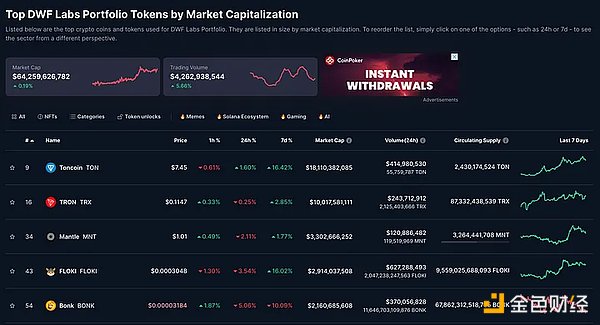
Data platform Cryptorank shows that from September last year to now, DWF Labs' comprehensive ROI in the primary market investment has reached 3.54%, with an investment range of US$3-10 million. It mainly invests in Ethereum ecology, DEX, Metaverse, games and privacy tracks, and is ranked 2nd among investment banks.
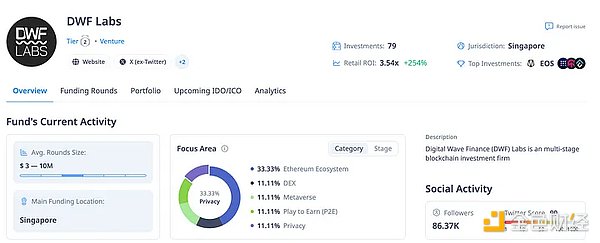
Among them, there was 1 50-fold increase, 2 25-fold increases, 3 10-fold increases, and most ended with 5-fold returns.
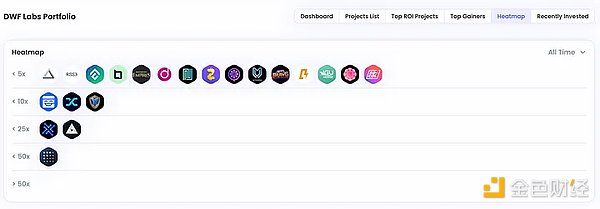
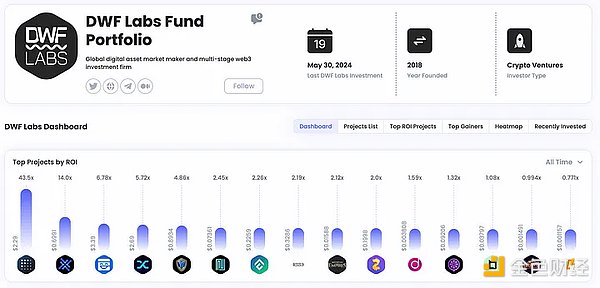
We can see the historical growth rate when we click on any project. For example, Fetch.ai has a one-year growth rate of 807.3%, which shows that DWF Labs has its own set of investment targets.
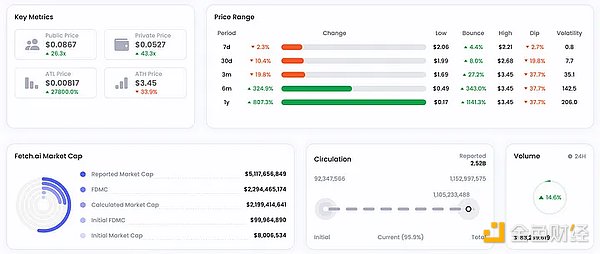
(III) DWF Labs' recent investment direction
DWF Labs has always insisted on selecting 5 tokens for investment every month. At the beginning of June, DWF Labs set its sights on Memecoin, a mass-manufacturing "counterattack" track.
DWF Labs has entered the Meme track with a high profile. Co-founder Andrei Grachev officially announced that he will invest more funds in Meme projects: $LADYS and $FLOKI have made clear investments, and three other projects are in communication.

On June 4, after DWF Labs purchased $FLOKI, the token broke through the historical high of $0.000343 on June 5, an increase of 45%.

On June 3, DWF Labs invested $5 million in $LADYS.

After DWF Labs invested in $LADYS, the market performance did not react as much as $FLOKI, with a 4.16% increase in the past 7 days. I wonder if this is an opportunity.
So let's analyze it:
(IV) About $LADYS
The Milady project was launched on May 5, 2023. It is a project related to the Milady NFT series. Its token is called $LADYS. All PEPE token and Milady Maker NFT holders can claim $LADYS.
As officially stated:
$LADYS is a meme coin with no intrinsic value or return expectations. This token has no connection with Charlotte Fang or her creation Milady Maker. It is just a tribute to a meme that we all love and identify with. This project has no formal team or roadmap and exists entirely for entertainment purposes.
(1)About the token
Project Name: Milady
Token Name: Milady Meme Coin ($LADYS)
Circulation Market Value: $217,114,922.00
Market Value Ranking: 301
Fully Diluted Market Value: $217,114,922.00
(3)$LADYS Bullish Indicator
Narrative: LADYS belongs to the Meme narrative. The Meme sector has a total of 614 normally operating tokens with a total current market value of 68,346,212,796.40. The average increase in the sector’s tokens in the past 7 days has increased by 3.1%.
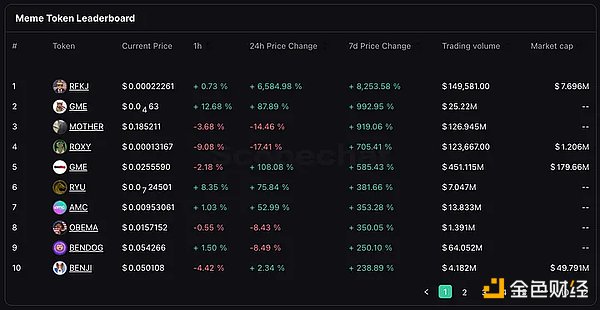
The increase in $LADYS in the past 7 days is -2.39%, which indicates that $LADYS has been weak in recent prices. This also means that the market has not yet fully realized its potential value. $LADYS may have other advantages or untapped potential that can serve as a catalyst for future growth.
From the perspective of funding rate: $LADYS currently has a funding rate of 0.06% on Bybit (futures), which means there are more long positions, indicating a bullish sentiment in the market because they are willing to pay a 0.06% fee to airdrop traders. The total open interest is currently worth $18,763,223.56, and the trading volume in the past 24 hours is $11,190,797.76.
(4)Neutral indicators
BOLL indicator: The current price of $LADYS is between the middle line and the upper line, indicating that the recent performance is relatively strong. The middle line may serve as support, and the upper line may be a short-term target.
RSI: The current RSI is 54.89, indicating that the market condition is neutral, with no obvious overbought or oversold signals.
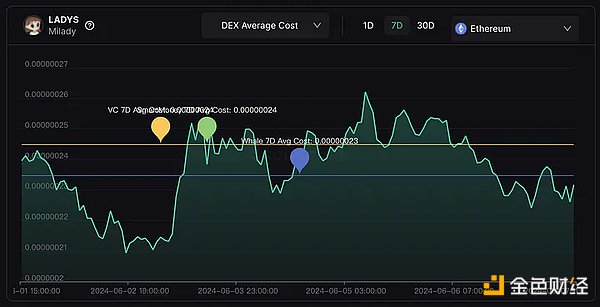
Here, this long article is basically over. DWF Labs is a controversial emerging market maker, operating with its own unique "venture capital + market making + incubation" model, which is unimaginable among previous market makers, so it is currently controversial.
DWF Labs is like Captain Jack in "Pirates of the Caribbean". He never plays by the rules. He offends most of the people on the sea and on the shore. Everyone wants to call him out when they see him. But he can't stand the fact that others are really capable, so he has gained a large number of "brainless fans".
According to the written explanation, DWF Labs is an industry catfish. The controversy over DWF will not stop, and it will intensify in the foreseeable future. Some people think that DWF Labs is an innovative pioneer in the Crypto industry, while others think that they are harvesters and creators of market instability.
No matter what it looks like, as a member of the industry, we are here to turn things around and should not be led astray at will. I always believe that those who are not understood by most people have greater opportunities.
DWF Labs gave us a clear signal in early June, and there are 3 projects under negotiation. According to industry inertia, when it is officially announced, it is the time for it to sneak into the market, so if you want to follow and buy, you have to do a good job of on-chain tracking, and wait for the official announcement to make money.
 JinseFinance
JinseFinance



























